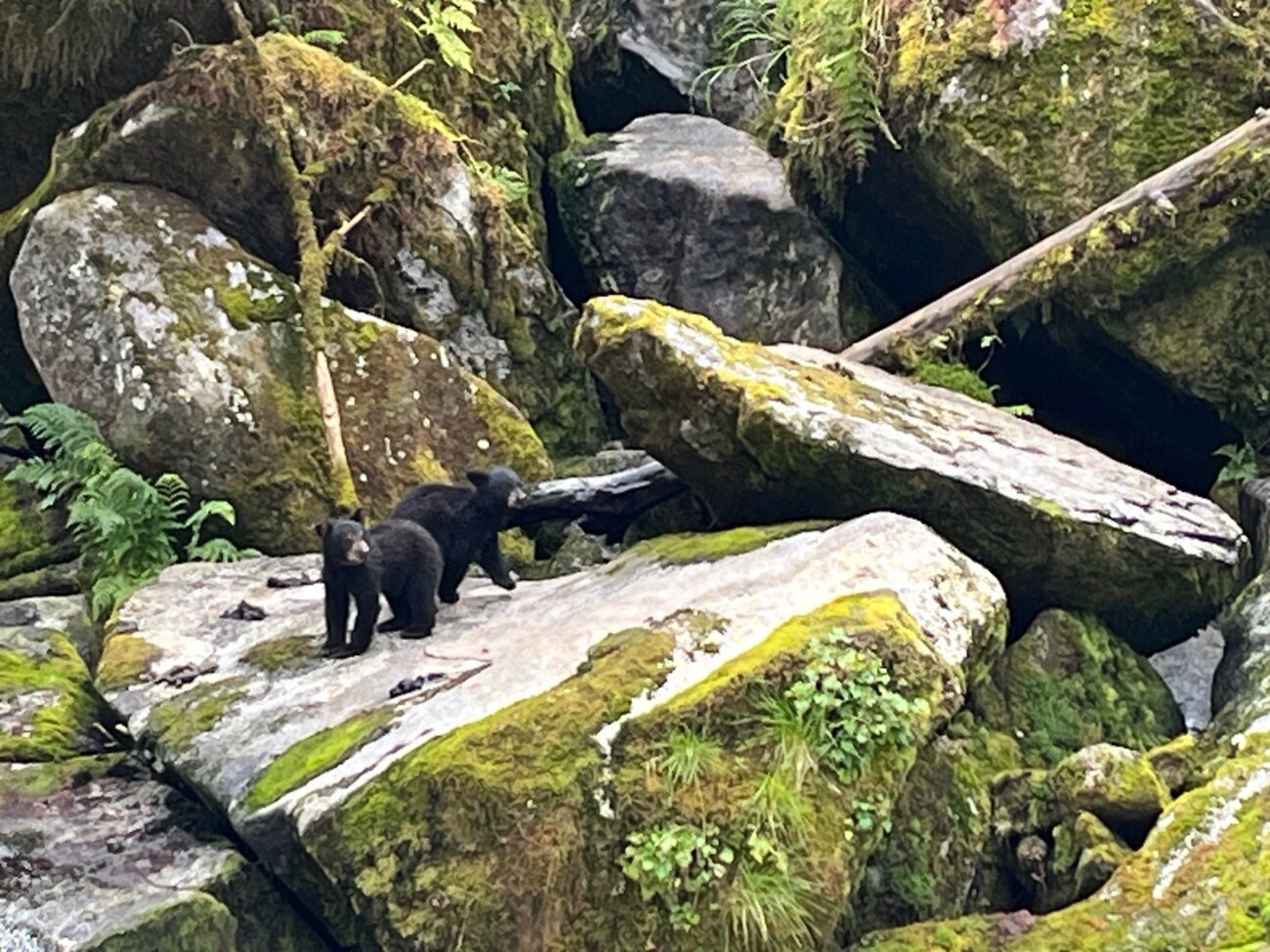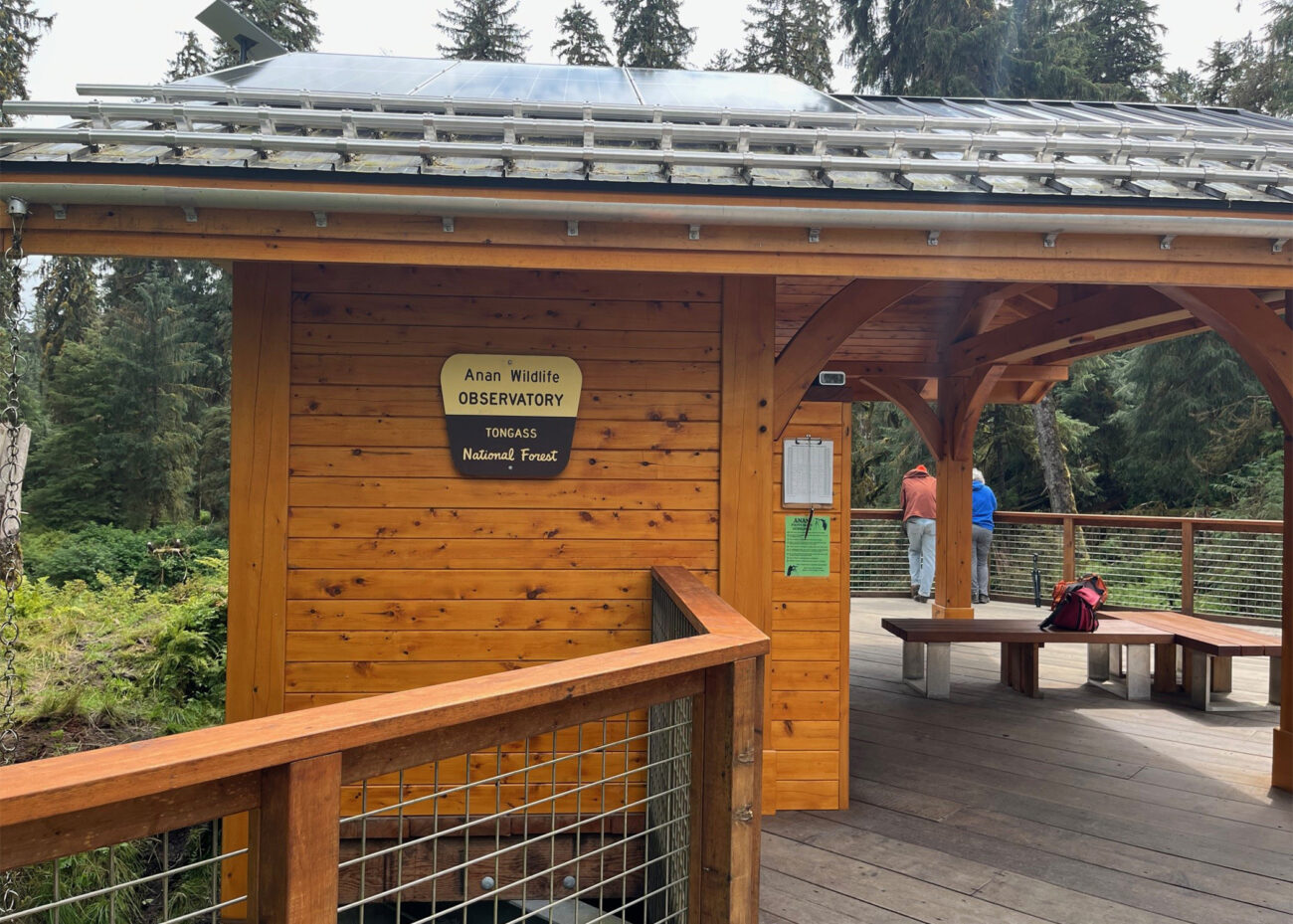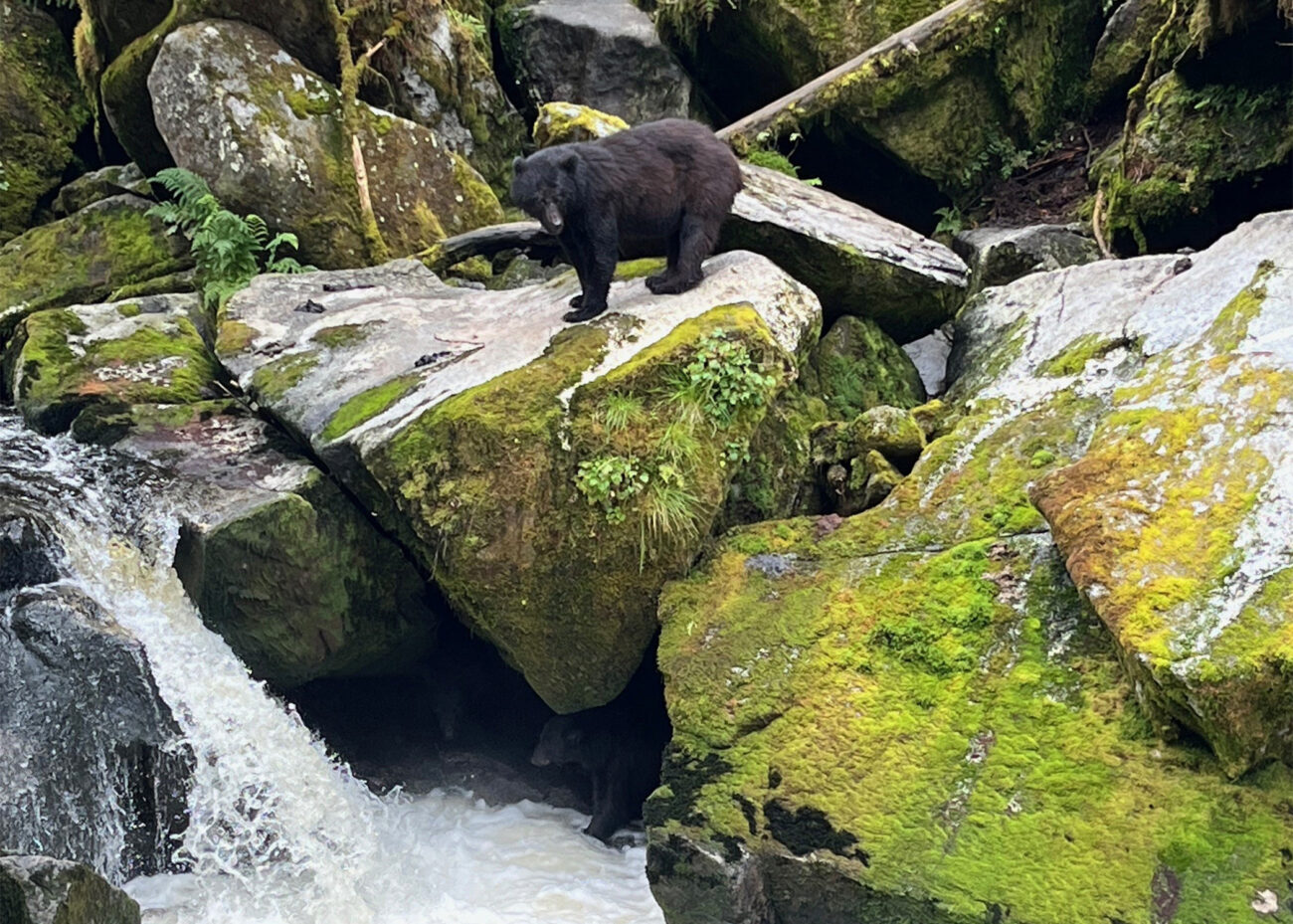
A group of six people filled a quarter-mile wilderness trail in the Tongass National Forest with chatter while walking towards a bear observatory platform. Salmon berries lined the trail, which began at Anan Lagoon, where everyone waded through the water from a small fishing boat to get to the trail. We tried avoiding the bear droppings as bald eagles and gulls swooped down into the rushing Anan Creek for salmon. The thousands of salmon swimming upstream were on a mission to spawn and up the creek, the bears were also hunting for them.
Tory Houser, Wrangell’s district ranger for the U.S. Forest Service, said July 24th marked a big deal for anyone who wants to see the bears at Anan Wildlife Observatory.
“We want to be able to show the wonderful resources to the world because many people will never be able to get to this very remote place,” she said. “Our camera live stream project went live at 11 o’clock and we’ve got it up on the screens here. Folks at home can go to explore.org and they can look up the bears of the Tongass and see the Anan bears.”
A few other people were at the bear observatory deck when we arrived. A big black bear stood in the creek and fished directly below us. To get closer, people needed to sign up on the sign up sheet to go down to the lower observatory deck. It’s scheduled in 10 minute increments. On top of the new live stream project, the Forest Service also recently put in a spiral staircase this year that leads down to the lower deck.
Collaboration with high school students
Two cameras attached to the lower observatory deck give an up close view of the bears in the creek. High school students planned and installed the live bear cameras at Anan through a collaboration between the Forest Service and T3 Alliance, which stands for Teaching through Technology. T3 Alliance teaches high school students STEM skills – Science, Technology, Engineering and Math. In Wrangell, it’s a five year program funded through a $300,000 grant and about 14 students worked closely with the Forest Service to set up the live bear cameras. They visited the observatory a few times before bear season was in full swing to brainstorm and get measurements. Houser said it took several more trips to get it fully installed, which installation began in May and was completed on July 19. In total, it took about seven months for them to finish this project.

But by next spring they plan on installing two more cameras with one being an underwater camera in the creek, where people can see bear claws fishing. The other would be at upward falls, where no humans go. Researchers want to see how bear activity compares with human interaction and without.
“We have to work with our students and their welding and manufacturing,” Houser said. “They’re creating this really cool structure to hold that camera underwater.”
Complexities in a very remote area
Having live cameras in a very remote area is complex. Without electricity, the students had to figure out how to set up an internet connection. They brought in Starlink, solar panels and a battery system. They also had to figure out how to keep the equipment safe from vandalism. Not necessarily from humans, but from innately curious bears.
As of now, the live cameras are on 24/7. But Houser said they’ll most likely be turned off in the winter to preserve the equipment. Plus, there won’t be much sunlight for the solar panels.
“Also, we think it would be kind of a lot of looking at water in the winter,” she said.
Not only water but there will be a lot of snow and the bears will be hibernating.
Houser said another big piece of the project is to help researchers and the public better understand the population of black and brown bears. She said it’s a great opportunity for citizen science – where the public can voluntarily make observations and add to research to Anan Wildlife Observatory, which attracts visitors from all over the globe.
“The idea is you can stop here and take a break”
“There’s so many things special about Anan,” she said. “One is that it’s one of the only places known to have both black and brown bears here. The resources are so rich that they tolerate each other in this small area on the creek. Another thing is that this area has been used for thousands of years, not just by us for tourism.”
Tlingit people came here to use this area for thousands of years. And that’s why Linguist Professor James Crippen joined the visiting group. He’s with McGill University in Montreal, Canada and documents the Lingít language and helps out with language revitalization efforts.
“Dzéiwsh and I’m from the Basket House of the Ḵak’weidí Deishitaan here in Wrangell,” he said. “I’m here mostly just as a member of my community interested in using the language more, so you know, seeing the places where we’ve used and done things and thinking about the names and traditions that are used in these areas.”
Crippen said in Lingít, Anan is spoken as ‘on-on’ and spelled An.áan.
“It’s a resting place where folks are resting,” he said. “The idea is you can stop here and take a break for a while.”
An.áan was where Tlingit came to fish
He said Anan was a place for the Tlingit to fish during the summer and pack up the food for their treks to their winter villages. And fishing alongside them would be the s’eek-or black and brown bears.
“It’s a real treat to be able to come home and see all the folks and catch up with people and work with with elders here in town,” Crippen said. “It’s kind of a dream job. I get to work what everybody else says is field work. For me I’m going home, that’s homework.”
He said it looks like good fishing when we look down at the bears hunting for salmon.
“Makes me hungry,” Crippen said. “I might have gone down there and join him, go pick up some lunch.”
“Well I know one is over there snacking,” I said.
“Yeah, I think he can keep it,” Crippen said. “I don’t want to argue with him for it.”
Bear activity changed since the 90s
Two retired bear scientists were also with us. Danielle Chi did research at Anan in the 90s because the Forest Service had questions about managing the tourist attraction.
“One of the things we found is it seemed like when a certain number of people were on the observatory, bear activity sort of dropped off,” she said.

But that’s changed. Chi said that bear activity is much higher now at the lower falls than in the 90s.
“I can’t explain that other than it’s exciting to see,” she said.
“It’s everything…it’s the bears and the eagles.”
One of the other visitors, Bruce Jamieson, from Wrangell, guided other people for a tour company. He said he loves going to Anan.
“It’s everything,” he said. “It’s the bears and the eagles. I love bringing people up here and showing our neighborhood.”
He said one of the bears he’s gotten to recognize is Scuba Sue.
“She puts up a show,” Jamieson said. “She dives underneath the water and everything. This is like being on the National Geographic Channel or the BBC nature channel. It’s so unreal. Every day is different.”
Though the livestream is not National Geographic quality, it’s still available for everyone to view online. And who knows, maybe people will start recognizing Scuba Sue and all the other bears at Anan.
The livestream can be viewed at explore.org under the Tongass National Forest section.











